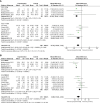Probiotics for the improvement of metabolic profiles in patients with metabolic-associated fatty liver disease: A systematic review and meta-analysis of randomized controlled trials
- PMID: 36407321
- PMCID: PMC9670148
- DOI: 10.3389/fendo.2022.1014670
Probiotics for the improvement of metabolic profiles in patients with metabolic-associated fatty liver disease: A systematic review and meta-analysis of randomized controlled trials
Abstract
Objective: This meta-analysis of randomized controlled trials (RCTs) was conducted to assess the efficacy of probiotics in the treatment of metabolic-associated fatty liver disease (MAFLD) mainly in terms of liver function, glucose and lipid metabolism, and inflammation.
Methods: RCTs were searched on PubMed, Web of Science, Embase, and the Cochrane Library until June 2022. A meta-analysis was performed on the therapeutic efficacy of probiotics on liver function, glucose and lipid metabolism, and inflammatory biomarkers by using RevMan 5.4 software.
Results: A total of 772 patients from 15 studies were included in the analysis. The methodological quality varied across studies. We found that adding probiotic therapies could reduce the levels of alanine aminotransferase [mean difference (MD): -11.76 (-16.06, -7.46), p < 0.00001], aspartate aminotransferase (MD: -9.08 (-13.60, -4.56), p < 0.0001], γ-glutamyltransferase [MD: -5.67 (-6.80, -4.54), p < 0.00001] and homeostasis model assessment-insulin resistance [MD: -0.62 (-1.08, -0.15), p = 0.01], in patients with MAFLD compared with those in control individuals. However, there was no statistically significant improvement in the levels of total cholesterol, triglycerides, low-density lipoprotein cholesterol, C-reactive protein and tumor necrosis factor α among patients with MAFLD. Subgroup analyses showed that other key factors, such as age, participants' baseline body mass index, and the duration of intervention, may influence probiotic therapy outcomes.
Conclusion: There is promising evidence that probiotic supplementation can reduce liver enzyme levels and regulate glycometabolism in patients with MAFLD. Further rigorous and long-term trials exploring these novel therapeutic perspectives are warranted to confirm these results.
Keywords: gut microbiota; gut-liver axis; liver enzymes; meta-analysis; metabolic associated fatty liver disease; probiotics; randomized controlled trials.
Copyright © 2022 Wang, Wang, Pang, Zheng, Cao, Feng, Ma and Wei.
Conflict of interest statement
The authors declare that they have no conflicts of interest and no financial interests related to the material in this manuscript.
Figures








Similar articles
-
Probiotics, prebiotics, and synbiotics for the improvement of metabolic profiles in patients with chronic kidney disease: A systematic review and meta-analysis of randomized controlled trials.Crit Rev Food Sci Nutr. 2021;61(4):577-598. doi: 10.1080/10408398.2020.1740645. Epub 2020 Apr 24. Crit Rev Food Sci Nutr. 2021. PMID: 32329633
-
The promising role of probiotic and synbiotic therapy in aminotransferase levels and inflammatory markers in patients with nonalcoholic fatty liver disease - a systematic review and meta-analysis.Eur J Gastroenterol Hepatol. 2019 Jun;31(6):703-715. doi: 10.1097/MEG.0000000000001371. Eur J Gastroenterol Hepatol. 2019. PMID: 31009401
-
Effects of probiotics on nonalcoholic fatty liver disease: a meta-analysis.World J Gastroenterol. 2013 Oct 28;19(40):6911-8. doi: 10.3748/wjg.v19.i40.6911. World J Gastroenterol. 2013. PMID: 24187469 Free PMC article. Review.
-
Efficacy of Probiotics and Synbiotics in Patients with Nonalcoholic Fatty Liver Disease: A Meta-Analysis.Dig Dis Sci. 2019 Dec;64(12):3402-3412. doi: 10.1007/s10620-019-05699-z. Epub 2019 Jun 15. Dig Dis Sci. 2019. PMID: 31203554 Review.
-
Effects of Probiotic Supplement in Pregnant Women with Gestational Diabetes Mellitus: A Systematic Review and Meta-Analysis of Randomized Controlled Trials.J Diabetes Res. 2019 Sep 5;2019:5364730. doi: 10.1155/2019/5364730. eCollection 2019. J Diabetes Res. 2019. PMID: 31583250 Free PMC article.
Cited by
-
Bacillus coagulans TCI711 Supplementation Improved Nonalcoholic Fatty Liver by Modulating Gut Microbiota: A Randomized, Placebo-Controlled, Clinical Trial.Curr Dev Nutr. 2024 Jan 19;8(3):102083. doi: 10.1016/j.cdnut.2024.102083. eCollection 2024 Mar. Curr Dev Nutr. 2024. PMID: 38510931 Free PMC article.
-
Water-Soluble Cellulose Acetate Changes the Intestinal Microbiota in Mice with Non-Alcoholic Steatohepatitis.Nutrients. 2025 Jan 29;17(3):500. doi: 10.3390/nu17030500. Nutrients. 2025. PMID: 39940357 Free PMC article.
-
Microbiota and Inflammatory Markers: A Review of Their Interplay, Clinical Implications, and Metabolic Disorders.Int J Mol Sci. 2025 Feb 19;26(4):1773. doi: 10.3390/ijms26041773. Int J Mol Sci. 2025. PMID: 40004236 Free PMC article. Review.
-
Metabolic-Dysfunction-Associated Fatty Liver Disease and Gut Microbiota: From Fatty Liver to Dysmetabolic Syndrome.Medicina (Kaunas). 2023 Mar 17;59(3):594. doi: 10.3390/medicina59030594. Medicina (Kaunas). 2023. PMID: 36984595 Free PMC article. Review.
-
Microbiome-centered therapies for the management of metabolic dysfunction-associated steatotic liver disease.Clin Mol Hepatol. 2025 Feb;31(Suppl):S94-S111. doi: 10.3350/cmh.2024.0811. Epub 2024 Nov 28. Clin Mol Hepatol. 2025. PMID: 39604327 Free PMC article. Review.
References
Publication types
MeSH terms
Substances
LinkOut - more resources
Full Text Sources
Medical
Research Materials

